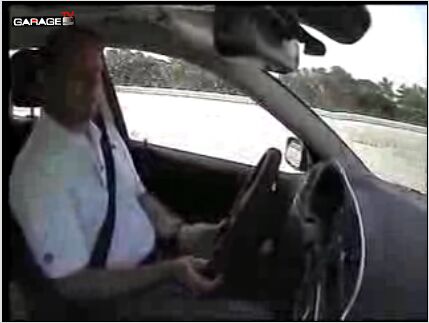Just Say No… To Shuffle Steering

Last year, Volkswagen decided to hand a truly spectacular insider freebie to the fellow who runs a popular VW owners’ forum: an all-expenses-paid race in the TDI Cup at Road America. The TDI Cup is meant to be a talent showcase for twentysomething novice drivers whose parents can come up with $45,000 and all related expenses, but VW waived all the age, talent, financial, and racing-resume requirements for our forum friend.
Prior to the event, several people asked me “How’s he gonna do?” My iron-clad prediction was that he would finish DFL, and that would only be because there’s no place in a race behind DFL. I’d only met the guy once, but I’d seen the video which is freeze-framed above, and that was enough for me to play amateur odds-maker. In this video, we repeatedly see him “shuffle-steer”. Shuffle-steering is a word for what most of us do on the street every day: change the position of our hands on the steering wheel while turning. It’s comfy, it’s useful for downtown parking, and I find it to be very useful when I’m texting on back roads, but on a racetrack, it is the mark of the chump.
There are a few extremely rare exceptions to this rule, and most race fans can probably name one or two. Rudi Uhlenhaut, the famous Mercedes-Benz race engineer and development driver of the Fifties and Sixties, was a shuffler. Rally drivers tend to shuffle because they frequently turn the wheel more than one hundred and eighty degrees in a corner. And the famous Evolution School teaches its autocrossing students a variation of shuffle-steering in which the driver makes one position change before the corner and maintains constant position through that corner.
99.999% percent of trackday and race drivers, however, will benefit immeasurably from having their hands in one place all the time, and I will explain why.
The human body has some amazing “easter eggs” hidden inside its neuro-muscular-kinesthetic-whatever structure. One of them was called “hand finds hand” by Uziel Gal, the designer of the Uzi submachine gun. Most people can easily put their hands together no matter whether they can see their hands or not. Behind your back, in dead of night, whatever. Most of us are perfect at it every time. It’s why Uzis are easier to reload than HK MP5s. Remember that the next time you’re planning to shoot up your workplace or impress Jodie Foster.
An extension of that ability is that most of us do not need to look at our hands to perform relatively precise motions with them. We write without looking at the paper, and it’s legible. We play Super Mario Brothers with our eyes on the screen. When I play “Just The Two Of Us” on my fabulous Heritage H535 Anniversary Edition, I know where Dmaj7 is and I don’t need to check the fretboard.
Drive through a wide-open parking lot with your hands at 9-and-3 on the steering wheel. Please don’t wrap your thumbs on the spokes; the first time you bounce a curb at VIR you’ll know why. Make a sharp right turn without changing the position of your hands on the wheel… and in the middle of that turn, quickly return the wheel to center. Easy as pie, right? You did it without thinking.
Now do the same thing, but instead of moving your hands to steer the car, “shuffle” the wheel through your hands. QUICK! RETURN TO CENTER! PRECISELY! What just happened?
You know what happened. It was sloppy and slow, and chances are that you didn’t get it perfect without a correction or two. When you are driving at the true limit of your tires — the zone in which a tenth of a mile per hour is the difference between nailing the exit and nailing the wall — that sloppiness will put you off the pace (at best) or off the track (at worst). Fast laps come when we introduce the smallest possible inputs to the steering. The fastest lap comes when we drive with our fingers, palms off the steering wheel, as Schumacher famously did. We want to have the absolute finest-grained control of the car possible, and that comes with fingers. You don’t write by locking your wrist and writing with your arm.
When we are driving at the limit, we will occasionally have to input corrective steering in a hurry. This is where keeping our hands in one place really pays off, because we will have to accomplish the following tasks:
- Unwind steering from our current position to catch the slide. This means going past “neutral” position in some cases.
- Briefly return the car to straight-ahead progress so we can apply the appropriate throttle to maintain tire load.
- Returning to a more appropriate amount of steering in our desired direction.
All three of these tasks are much easier if we know where our tires are pointing, and unless we are willing to take our eyes off the road and look at the steering wheel in the middle of a race or high-speed trackday the only way to “know” is that is through your hands. If you are sliding sideways down the hill in Road Atlanta’s Turn Twelve, with the nose of your car pointed right at a concrete wall and the tach pinned to the limiter in fourth gear, do you want to have to guess at which way your tires are really pointing? Of course not. You want that information firmly locked into your hands. It’s been demonstrated that our hands can actually make certain corrections in less time than it takes for the signal to travel all the way to the brain and back. (For more information, try reading Growing Up With Lucy.) That could literally save your life, and if you shuffle-steer you are throwing that ability away.
Try getting out of the shuffle-steer habit on your daily commute, on the freeway, on your favorite back road. Use constant hand positioning to give your car honest, true, low-violence inputs at the wheel. It will reward you in kind.
And our forum pal? He qualified DFL for the race, but he beat my prediction by finishing second-to-DFL among racers who didn’t crash or go off-track. The kid he beat? Someone who earned his spot by winning “iRacing” events, and who had never been on a racetrack before. Do video games make you a better driver? That’s a topic for another time.
(Nobody is born knowing this stuff so I would like to thank Brian Makse, Aaron Povoledo, Ross Bentley, Randy Pobst, and the other drivers who have instructed and inspired me since I put down my bicycle and picked up my SCCA license.)

More by Jack Baruth
Latest Car Reviews
Read moreLatest Product Reviews
Read moreRecent Comments
- SCE to AUX Range only matters if you need more of it - just like towing capacity in trucks.I have a short-range EV and still manage to put 1000 miles/month on it, because the car is perfectly suited to my use case.There is no such thing as one-size-fits all with vehicles.
- Doug brockman There will be many many people living in apartments without dedicated charging facilities in future who will need personal vehicles to get to work and school and for whom mass transit will be an annoying inconvenience
- Jeff Self driving cars are not ready for prime time.
- Lichtronamo Watch as the non-us based automakers shift more production to Mexico in the future.
- 28-Cars-Later " Electrek recently dug around in Tesla’s online parts catalog and found that the windshield costs a whopping $1,900 to replace.To be fair, that’s around what a Mercedes S-Class or Rivian windshield costs, but the Tesla’s glass is unique because of its shape. It’s also worth noting that most insurance plans have glass replacement options that can make the repair a low- or zero-cost issue. "Now I understand why my insurance is so high despite no claims for years and about 7,500 annual miles between three cars.


































Comments
Join the conversation
Jack, After all of the race training you've taken it's not surprising you're fast. Congrats. Sharing techniques with readers... even better. It's a shame though that you can't even do that without belittling someone. I guess it plays well in forums and raises eyebrows but it also seems kind of small.
With all due respect, but I believe the writer is very wrong in regards to the steering input topic. Leading law enforcement agencies, military organizations and close protection training institutes are teaching "shuffle steering". And they are teaching it for a reason. I personally use this technique for a number of years on my daily driving, on my professional driving, on the race track or auto cross/precision course. One of the top world's drivers, Bobby Ore, is advocating (and teaching) the shuffle steering for more than 20 years. Bobby Ore is a veteran stunt performance/precision driver and for more than 25 years he is teaching military, FBI, CIA and Secret Service agents to drive in extreme circumstances. He holds 13 automotive world records (to date), including one for driving a London double-decker bus on two wheels for 810 feet. As a stunt driver he is one of the most accomplished Hollywood stunt drivers and only a hand full of other drivers in the world can match and/or replicate his driving. Another accomplished driver advocating shuffle steering is Sgt. Dave Storton, the Director of the San Jose Police Academy. He holds a Master's Degree in Adult Education and is the lead instructor for the Emergency Vehicle Operations Course (EVOC) at the San Jose Police Academy. As well he is a lead instructor for the local regional academy. He teaches EVOC instructor courses, advanced EVOC instructor courses, off road EVOC, counter-terrorist / dignitary protection driving, and motion picture stunt driving. Dave has trained over 3,500 drivers. If those drivers are advocating shuffle steering and they are wrong.. .. I want to be wrong too. I would personally have absolutely no problem to get together on a driving pad, performance/precision course and/or racing track with Jack, or anyone else for that matter, to settle this issue, "Myth Busters" style and see which steering input if the most accurate, ergonomic and safe. We can even take bets.. .. Anyone?